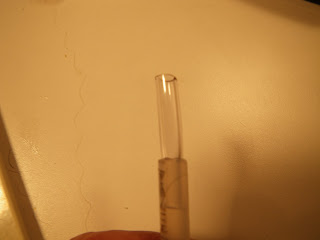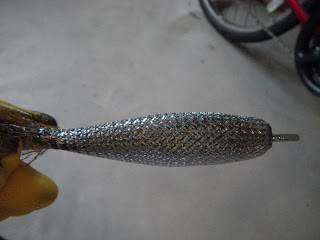
I'm getting ready for my trip to Mexico to chase Roosterfish. I'm discouraged by the number of people who tell me they have tried to catch them on the fly for four or five days and never had a fish. But I'm a fly fisherman; hope springs eternal. I tie some new flies and I think how can those fish refuse?
The Squishy Fish is the creation of Peter Hylander of Seattle Saltwater. I suppose anything that I tie for fishing is a fly. Well sort of. I feel like I am building these flies more than I am tying them. The doubling is a somewhat different use of the mylar than I have experienced with other baitfish imitiations. It's always good to learn new things.
I have tied a lot of tube flies for Salmon fishing. I like my tube fly vise from HMH.

Alas the pins are too short for this fly. I created a longer pin by cutting a piece out of the corner of a clothes hangar. I was kind of pleased with myself for problems solving.


The first step is to assemble the three sizes of tubing and the cone head. The cone head is epoxied to the tubing. If you tie this fly get that middle piece of tubing well into the first piece. It shouldn't stick out more than 1/8 inch when you are finished or the cone won't slide down far enough. When you insert the smallest piece of tubing into the middle piece its okay if the middle piece goes down inside the largest piece a bit since the space will be filled with epoxy. After the epoxy has dried the tail end needs to be melted so that there is something for the thread to butt up against. Holding it to a lighter and then pressing on a paint stick worked fine.




This is 10 inches of mylar slid over the tube. I have tied it very, very tightly so it won't slip in later steps. It is tied right up against the conehead.



After tying down the mylar near the cone a good coat of Softex is applied on the thread. It has to dry before moving on to the next step.
One side of the mylar is pushed back over the cone so that the finished Squishy Fish is actually double layered. This step ended up being much simpler than I anticipated. The mylar slides right back over the cone easily.


It is easier to tie off the tail if the Squishy Fish is turned around for this step.

Pushing the tail back towards the head gives the fly the shape of a fish. It is tied off just in front of the melted tubing.
The fly needs another application of Softex where the tail is tied off.

The entire fly is dipped in Softex. This step is messy. You need to wear rubber gloves and to have something for the drips to fall on. I didn't plan to make any drips but I sure did. A plastic garbage bag works nicely. After the fly drains which will take about 30 seconds it needs to wiped off with a paper towel. The blue shop towels which are just heavier paper towels work better. This step is really messy. That is a stream of Softex draining off the nose of the fly.

Cut open clothes hangars worked great for drying the flies. The green bag next to the Squishy Fish is my Carp weigh sling which was also drying out.

Notice the difference in the shape of the two flies that are nearest. The narrow one is a result of me not tying down the mylar firmly enough so it slipped forward.

The flies dried for four hours and then I was back in business. To give coloration I sprayed the backs with green paint. Rubber gloves were necessary again. A quick "psssst" is all it takes.



The went back up on the hangars to dry.
The last step is to apply the eyes. A slightly sticky back allows you to put them in place. The eyes need a coat of Softex over them to hold them in place.
Here is a squadron of Squishy Fish complete with eyes ready to fly across my garage.

How can those Roosters possibly deny me?









Quite a process. I have built a couple patterns on tubes also but not nearly that involved. Good luck in el Mexico!
ReplyDeleteHi there,
ReplyDeleteSorry for my ignorance, but I am rather new to fly-tying and I was wondering where and how do you fix a hook to these great looking "Squishy Fish"?
Phil
Phil,
DeleteSince these flies are tied on a tube, the leader/tippet, passes through the tube and a hook is tied o your line. The knot or the eye of the hook is then jammed into the tube to hold the hook inline with the fly.
Did the flies work for the roosters and were you fishing from a boat or beach?
ReplyDelete